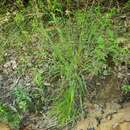Comments
provided by eFloras
No specimens are known from Connecticut; Carex mitchelliana may be expected to occur there. The species is known from fewer than 100 extinct and extant populations located predominantly along the Atlantic and Gulf coastal plains from Massachusetts to Alabama. Allozyme data demonstrated that the taxon, although not common, is genetically diverse and is closely related to the progenitor of the species complex (L. P. Bruederle et al. 1989).
- license
- cc-by-nc-sa-3.0
- copyright
- Missouri Botanical Garden, 4344 Shaw Boulevard, St. Louis, MO, 63110 USA
Description
provided by eFloras
Plants cespitose. Culms acutely angled, 40–140 cm, scabrous. Leaves: basal sheaths brown; sheaths of proximal leaves bladeless, scabrous, fronts red-brown to copper-brown, spots absent, indistinctly ladder-fibrillose, apex U-shaped; blades hypostomic, 13–35 cm × 3–8 mm, papillose abaxially. Inflorescences: peduncle of proximal spike 0.6–3 cm; proximal bract longer than inflorescence, 1.5–6.2 mm wide. Spikes 2–4 pistillate, 1–2 staminate; pendent; proximal pistillate spike 3.1–7.9 cm × 3.6–7.4 mm. Pistillate scales pale to copper-brown; 2.9–6.3 mm (including awn), apex of body truncate, awned, scabrous. Perigynia ascending, pale brown, 1–5-veined abaxially or veinless, scarcely inflated, loosely enclosing achenes, ovoid, 2.5–3.9 × 1.3–2.1 mm, dull, apex acute, papillose over entire surface; beak 0.1–0.3 mm. Achenes not constricted. 2n = 66.
- license
- cc-by-nc-sa-3.0
- copyright
- Missouri Botanical Garden, 4344 Shaw Boulevard, St. Louis, MO, 63110 USA
Distribution
provided by eFloras
Ala., Del., Fla., Ga., Ky., Md., Mass., Miss., N.J., N.Y., N.C., Pa., R.I., S.C., Tenn., Va.
- license
- cc-by-nc-sa-3.0
- copyright
- Missouri Botanical Garden, 4344 Shaw Boulevard, St. Louis, MO, 63110 USA
Habitat
provided by eFloras
Swamps, floodplain forests, wet meadows, stream edges, margins of lakes and ponds, roadside ditches; 0–500m.
- license
- cc-by-nc-sa-3.0
- copyright
- Missouri Botanical Garden, 4344 Shaw Boulevard, St. Louis, MO, 63110 USA
Synonym
provided by eFloras
Carex crinita Lamarck var. mitchelliana (M. A. Curtis) Gleason
- license
- cc-by-nc-sa-3.0
- copyright
- Missouri Botanical Garden, 4344 Shaw Boulevard, St. Louis, MO, 63110 USA
Comprehensive Description
provided by North American Flora
Carex mitchelliana M. A. Curt. Am. Jour. Sci. 44: 84. 1843
" Carex gynandra Schw." Boott, 111. Carex 18, in greater part. 1858.
Carex gynandra var. caroliniana Olney, Caric. Bor.-Am. 5. 1871. (As to reference to C. Mitchelliana M. A. Curt.; not as to type.)
Cespitose, from stout, elongate rootstocks, but not sending forth slender horizontal stolons, the culms 5-9 dm. high, rather slender, much exceeding leaves, sharply triangular, but not winged, smooth or nearly so, dull-purplish-brown at base, aphyllopodic, the basal sheaths little or not at all filamentose; sterile shoots aphyllopodic, few-leaved; leaves with well-developed blades usually 2-4 to a fertile culm, the blades erect, flat with slightly revolute margins, light-green, thin but firm, usually 1-2 dm. long, 2.5-4.5 mm. wide, short-tapering, roughened on margins towards apex, the sheaths finely hispidulous, yellowish-brown-tinged ventrally, concave and little prolonged upward at mouth, the ligule much longer than wide; terminal spike staminate (often with a smaller one at its base), slender-peduncled, narrowly linear, 2.5-4 cm. long, 2.5-3 mm. wide, the scales obovate, obtuse, or retuse, rounded to mucronate or cuspidate or awned, reddish-brown with lighter center and hyaline margins; pistillate spikes usually 3, more or less strongly separate, drooping on slender, slightly roughened peduncles, 0.3-2.5 cm. long, the spikes cylindric or linear-cylindric, 2-4.5 cm. long, 6-8 mm. wide, densely flowered above, somewhat attenuate at base, the perigynia 50-125, ascending in several rows; bracts leaflet-like, not sheathing, the lowest at least exceeding culm; scales ovate to obovate, reddish-brown with green 3-nerved center and narrow hyaline margins, narrower than the perigynia, the lower with the body retuse at apex and strongly rough-awned and the whole twice the length of the perigynia, the middle short-awned and equaling the perigynia, and the upper shorter than the perigynia, not retuse, scarcely cusped; perigynia oblongovate, flattened-biconvex and 2-edged, not inflated, 2.5-3 mm. long, 1.75 mm. wide, membranaceous, 2-ribbed (the marginal) and slenderly few-nerved, strongly papillate all over, yellow-glandular, dull-yellowish-brown, rounded and slenderly substipitate at base, abruptly minutely apiculate, the beak 0.1-0.2 mm. long, entire; achenes lenticular, small, suborbicular, 1.75 mm. long, 1.5 mm. wide, loosely enveloped in lower half of perigynium, brownish, substipitate, not constricted in middle, strongly apiculate, jointed with the slender, straight style; stigmas 2, slender, short.
Type locality: Chatham County, North Carolina.
Distribution: Swampy woodlands, mostly on the coastal plain or near it, acid soils, Massachusetts to Florida, east of the mountains. (Specimens examined from Massachusetts, Rhode Island, New York, New Jersey, Delaware, Virginia, South Carolina, Georgia, Alabama, Florida.)
- bibliographic citation
- Kenneth Kent Mackenzie. 1935. (POALES); CYPERACEAE; CARICEAE. North American flora. vol 18(7). New York Botanical Garden, New York, NY

